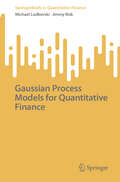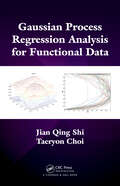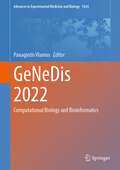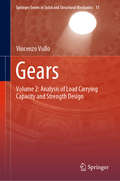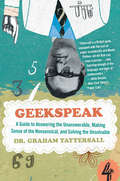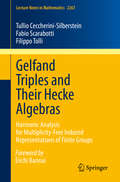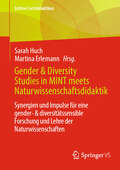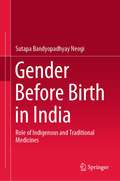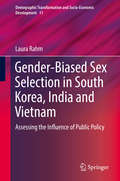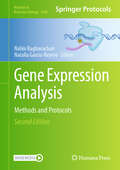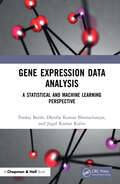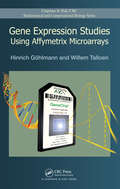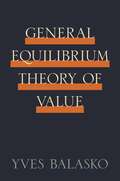- Table View
- List View
Gaussian Process Models for Quantitative Finance (SpringerBriefs in Quantitative Finance)
by Michael Ludkovski Jimmy RiskThis book describes the diverse applications of Gaussian Process (GP) models in mathematical finance. Spurred by the transformative influence of machine learning frameworks, the text aims to integrate GP modeling into the fabric of quantitative finance. The first half of the book provides an entry point for graduate students, established researchers and quant practitioners to get acquainted with GP methodology. A systematic and rigorous introduction to both GP fundamentals and most relevant advanced techniques is given, such as kernel choice, shape-constrained GPs, and GP gradients. The second half surveys the broad spectrum of GP applications that demonstrate their versatility and relevance in quantitative finance, including parametric option pricing, GP surrogates for optimal stopping, and GPs for yield and forward curve modeling. The book includes online supplementary materials in the form of half a dozen computational Python and R notebooks that provide the reader direct illustrations of the covered material and are available via a public GitHub repository.
Gaussian Process Regression Analysis for Functional Data
by Jian Qing Shi Taeryon ChoiGaussian Process Regression Analysis for Functional Data presents nonparametric statistical methods for functional regression analysis, specifically the methods based on a Gaussian process prior in a functional space. The authors focus on problems involving functional response variables and mixed covariates of functional and scalar variables.Coveri
Gaussian Processes on Trees: From Spin Glasses to Branching Brownian Motion
by Anton BovierBranching Brownian motion (BBM) is a classical object in probability theory with deep connections to partial differential equations. This book highlights the connection to classical extreme value theory and to the theory of mean-field spin glasses in statistical mechanics. Starting with a concise review of classical extreme value statistics and a basic introduction to mean-field spin glasses, the author then focuses on branching Brownian motion. Here, the classical results of Bramson on the asymptotics of solutions of the F-KPP equation are reviewed in detail and applied to the recent construction of the extremal process of BBM. The extension of these results to branching Brownian motion with variable speed are then explained. As a self-contained exposition that is accessible to graduate students with some background in probability theory, this book makes a good introduction for anyone interested in accessing this exciting field of mathematics.
Gaṇitānanda: Selected Works of Radha Charan Gupta on History of Mathematics
by K. RamasubramanianThis book includes 58 selected articles that highlight the major contributions of Professor Radha Charan Gupta—a doyen of history of mathematics—written on a variety of important topics pertaining to mathematics and astronomy in India. It is divided into ten parts. Part I presents three articles offering an overview of Professor Gupta’s oeuvre. The four articles in Part II convey the importance of studies in the history of mathematics. Parts III–VII constituting 33 articles, feature a number of articles on a variety of topics, such as geometry, trigonometry, algebra, combinatorics and spherical trigonometry, which not only reveal the breadth and depth of Professor Gupta’s work, but also highlight his deep commitment to the promotion of studies in the history of mathematics. The ten articles of part VIII, present interesting bibliographical sketches of a few veteran historians of mathematics and astronomy in India. Part IX examines the dissemination of mathematical knowledge across different civilisations. The last part presents an up-to-date bibliography of Gupta’s work. It also includes a tribute to him in Sanskrit composed in eight verses.
GeNeDis 2020: Computational Biology and Bioinformatics (Advances in Experimental Medicine and Biology #1338)
by Panayiotis VlamosThe 4th World Congress on Genetics, Geriatrics and Neurodegenerative Diseases Research (GeNeDis 2020) focuses on the latest major challenges in scientific research, new drug targets, the development of novel biomarkers, new imaging techniques, novel protocols for early diagnosis of neurodegenerative diseases, and several other scientific advances, with the aim of better, safer, and healthier aging. Computational methodologies for implementation on the discovery of biomarkers for neurodegenerative diseases are extensively discussed. This volume focuses on the sessions from the conference regarding computational biology and bioinformatics.
GeNeDis 2022: Computational Biology and Bioinformatics (Advances in Experimental Medicine and Biology #1424)
by Panagiotis VlamosThe 5th World Congress on Genetics, Geriatrics and Neurodegenerative Diseases Research (GeNeDis 2022) focuses on the latest major challenges in scientific research, new drug targets, the development of novel biomarkers, new imaging techniques, novel protocols for early diagnosis of neurodegenerative diseases, and several other scientific advances, with the aim of better, safer, and healthier aging. Computational methodologies for implementation on the discovery of biomarkers for neurodegenerative diseases are extensively discussed. This volume focuses on the sessions from the conference regarding computational biology and bioinformatics.
Gears: Volume 1: Geometric and Kinematic Design (Springer Series in Solid and Structural Mechanics #10)
by Vincenzo VulloThe book explores the geometric and kinematic design of the various types of gears most commonly used in practical applications, also considering the problems concerning their cutting processes. The cylindrical spur and helical gears are first considered, determining their main geometric quantities in the light of interference and undercut problems, as well as the related kinematic parameters. Particular attention is paid to the profile shift of these types of gears either generated by rack-type cutter or by pinion-rack cutter. Among other things, profile-shifted toothing allows to obtain teeth shapes capable of greater strength and more balanced specific sliding, as well as to reduce the number of teeth below the minimum one to avoid the operating interference or undercut. These very important aspects of geometric-kinematic design of cylindrical spur and helical gears are then generalized and extended to the other examined types of gears most commonly used in practical applications, such as: straight bevel gears; crossed helical gears; worm gears; spiral bevel and hypoid gears. Finally, ordinary gear trains, planetary gear trains and face gear drives are discussed. Includes fully-developed exercises to draw the reader's attention to the problems that are of interest to the designer, as well as to clarify the calculation procedure Topics are addressed from a theoretical standpoint, but in such a way as not to lose sight of the physical phenomena that characterize the various types of gears which are examined The analytical and numerical solutions are formulated so as to be of interest not only to academics, but also to designers who deal with actual engineering problems concerning the gears
Gears: Volume 2: Analysis of Load Carrying Capacity and Strength Design (Springer Series in Solid and Structural Mechanics #11)
by Vincenzo VulloThis book explores the geometric and kinematic design of the various types of gears most commonly used in practical applications, also considering the problems concerning their cutting processes. The cylindrical spur and helical gears are first considered, determining their main geometric quantities in the light of interference and undercut problems, as well as the related kinematic parameters. Particular attention is paid to the profile shift of these types of gears either generated by rack-type cutter or by pinion-rack cutter. Among other things, profile-shifted toothing allows to obtain teeth shapes capable of greater strength and more balanced specific sliding, as well as to reduce the number of teeth below the minimum one to avoid the operating interference or undercut. These very important aspects of geometric-kinematic design of cylindrical spur and helical gears are then generalized and extended to the other examined types of gears most commonly used in practical applications, such as straight bevel gears; crossed helical gears; worm gears; spiral bevel and hypoid gears. Finally, ordinary gear trains, planetary gear trains and face gear drives are discussed. This is the most advanced reference guide to the state of the art in gear engineering. Topics are addressed from a theoretical standpoint, but in such a way as not to lose sight of the physical phenomena that characterize the various types of gears which are examined. The analytical and numerical solutions are formulated so as to be of interest not only to academics, but also to designers who deal with actual engineering problems concerning the gears
Geekspeak
by Graham TattersallHow big is your vocabulary? How heavy is your house? Do the dead outnumber the living? What are the best words to use in a personal ad? We humans are a curious species, prone to think, ruminate, reflect, cogitate, mull over, and philosophize. We long to explain away the world around us, to answer all those seeming unanswerables: Why are we here? Is there a God? Is there life after death? And, above all, how many houseflies does it take to pull a car? A confirmed and superior geek, Dr. Graham Tattersall has rescued math from the prison of the classroom and put it to use in novel and unexpected ways to explain some oft-pondered mysteries of the world. Geekspeak is an essential tool that will help you exercise your brain and solve the unsolvable, make you sound intelligent so you can impress your friends, and enable you to better understand the fascinating world in which we live in ways never possible before. Math has a new champion, and the geeks a new king.
Gelfand Triples and Their Hecke Algebras: Harmonic Analysis for Multiplicity-Free Induced Representations of Finite Groups (Lecture Notes in Mathematics #2267)
by Tullio Ceccherini-Silberstein Fabio Scarabotti Filippo TolliThis monograph is the first comprehensive treatment of multiplicity-free induced representations of finite groups as a generalization of finite Gelfand pairs. Up to now, researchers have been somehow reluctant to face such a problem in a general situation, and only partial results were obtained in the one-dimensional case. Here, for the first time, new interesting and important results are proved. In particular, after developing a general theory (including the study of the associated Hecke algebras and the harmonic analysis of the corresponding spherical functions), two completely new highly nontrivial and significant examples (in the setting of linear groups over finite fields) are examined in full detail. The readership ranges from graduate students to experienced researchers in Representation Theory and Harmonic Analysis.
Gems of Combinatorial Optimization and Graph Algorithms
by Andreas S. Schulz Martin Skutella Sebastian Stiller Dorothea WagnerAre you looking for new lectures for your course on algorithms, combinatorial optimization, or algorithmic game theory? Maybe you need a convenient source of relevant, current topics for a graduate student or advanced undergraduate student seminar? Or perhaps you just want an enjoyable look at some beautiful mathematical and algorithmic results, ideas, proofs, concepts, and techniques in discrete mathematics and theoretical computer science? Gems of Combinatorial Optimization and Graph Algorithms is a handpicked collection of up-to-date articles, carefully prepared by a select group of international experts, who have contributed some of their most mathematically or algorithmically elegant ideas. Topics include longest tours and Steiner trees in geometric spaces, cartograms, resource buying games, congestion games, selfish routing, revenue equivalence and shortest paths, scheduling, linear structures in graphs, contraction hierarchies, budgeted matching problems, and motifs in networks. This volume is aimed at readers with some familiarity of combinatorial optimization, and appeals to researchers, graduate students, and advanced undergraduate students alike.
Gender & Diversity Studies in MINT meets Naturwissenschaftsdidaktik: Synergien und Impulse für eine gender- & diversitätssensible Forschung und Lehre der Naturwissenschaften (Edition Fachdidaktiken)
by Martina Erlemann Sarah HuchGender und dessen Zusammenwirken mit weiteren Diversity-Dimensionen wie etwa soziale Herkunft, ein (zugeschriebener) Migrationshintergrund oder sexuelle Orientierung stehen an Hochschulen verstärkt im Fokus. Gefordert sind dabei auch gender- und diversitysensible Ausrichtungen der Forschung und Lehre der MINT-Fächer sowie der hochschulischen Lehramtsausbildung für MINT. Welche inhaltliche Relevanz haben Gender- und Diversity-Aspekte in Fachkultur, Forschungsinhalten sowie im Wissenschaftsverständnis der Naturwissenschaften? Wie strukturieren Geschlecht und andere soziale Differenzkategorien die Forschung? Wie kann eine Gender- und Diversity-Kompetenzen vermittelnde Lehrer*innenbildung aussehen?Auf diese Fragen geben die interdisziplinären Beiträge der Wissenschaftler*innen, etwa aus Physik, Biologie, Medizin, Feminist Science & Technology Studies sowie die naturwissenschaftlichen Fachdidaktiken Antworten. Ansätze sowie Wissensbestände der Gender & Diversity Studies in MINT werden mit den gender- und diversityausgerichteten Naturwissenschaftsdidaktiken zusammengeführt. Mit vielfältigen Anregungen ermutigen sie zu einer gender- und diversityorientierten Ausrichtung der (eigenen) Forschung und Lehre.
Gender Before Birth in India: Role of Indigenous and Traditional Medicines
by Sutapa Bandyopadhyay NeogiThis book focuses on the role of the indigenous system of medicine or traditional medicines in gender selection in India. Issues such as the harmful effects of traditional practices on the health of the woman and the foetus during early pregnancy are explored in this book. It analyses the social and cultural practices and establishes linkages with modern methods of scientific investigations. It discusses how systematic exploration lends evidence of harmful traditional practices. The book is an important read for researchers, healthcare professionals and students in the field of medicine, public health and social sciences. It is an extremely valuable resource for all those engaged in research of traditional and modern systems of medicine.
Gender Inequalities and Vulnerability of sub-Saharan Adolescents: The Case of Benin (Demographic Transformation and Socio-Economic Development #15)
by Yves Charbit Mustapha OmraneThis book analyses the vulnerability of adolescent girls, which results from cumulative inequalities: gender, lack of education, residential, and poverty. It is based on original analyses of data from the national survey carried out by the National Institute of Statistics and Economic Analysis in collaboration with UNICEF.The book discusses three main themes. First, the experience of adolescence: access to globalization, via access to TIC (Trusted Internet Connections) and mass media; subjective well-being; smoking and alcohol consumption; child discipline and domestic violence are discussed. Secondly, the book focusses on the beginning of fertile life: child marriage; early pregnancy; prenatal care; birth weight and breastfeeding. HIV/AIDS and sexuality.The third theme touches on the potential contribution of adolescents to harvesting the demographic dividend: fertility and contraception; postnatal care and vaccination of children; pre-school learning; education and gender; household health vulnerability (water and sanitation). On the basis of the analyses of data, implications regarding concrete policy measures aimed at reducing the vulnerability of adolescents are identified at the end of each chapter.Through the richness of the analyses and the methodological rigor, this book provides an interesting read to both specialists and non-specialists interested in adolescence and the future of Benin, Africa and beyond.The [basis of the] English translation of this book from its French original manuscript was done with the help of artificial intelligence. A subsequent human revision of the content was done by the author.
Gender and Family in Japan (Monograph Series of the Socio-Economic History Society, Japan)
by Nobuko Okuda Tetsuhiko TakaiThis book is the 6th volume of the Monograph Series of the Socio-Economic History Society, Japan. The book focuses on how economic developments changed the everyday lives of ordinary women in early-modern and modern Japan. Different from precedent gender studies, the spotlight here is on the daily activities and structural positions of women rather than feminist movements or activities of elite women. Using demography, anthropometrics, and labour economics, this book explicates childcare, physical development of girls, and women’s labour migration. The dynamics of ordinary women in prewar Japan may change deep-rooted images of women as oppressed beings. Using quantitative data multi-dimensionally with the latest statistical analysis methods, this book shows how Japanese economic historians can contribute to historians of gender and family who are interested in early-modern and modern Japan. The first part consists of four chapters that discuss women migrant workers in the Tokugawa period, women’s work, and family strategies in the underdeveloped regions of the country, conflicts between child-rearing and women’s work on family farms, and living standards of teenaged girls in early twentieth-century Japan. Those chapters provide a bridge between economic historians and feminist historians and articulate new research fields for both. The second part, comprising four book reviews, illustrates how the gender concept has been adopted in family and gender historiography in Japan.
Gender in STEM Education in the Arab Gulf Countries
by Martina Dickson Melissa McMinn Dean CairnsThis book explores the critical issues in gender and STEM education in the Arabian Gulf, written within a context of educational systems developing rapidly over recent decades. With the ever-growing need for a highly skilled, gender-inclusive STEM workforce, the issues raised in this book are more topical than ever. It presents chapters from various sectors such as children’s perceptions of science, scientists and their work, adolescent and university years by studying large-scale secondary data variations across countries in the region and finally presenting work relating to gender in STEM education. The book closes with a chapter on factors of success in female leaders’ STEM career journeys. It offers recommendations for both policy and practices in gender equity in the STEM workplace, based on their experiences. This book is written in a highly accessible yet academic manner. It is an essential resource for a wide-ranging audience interested in the complex relationships between gender and STEM.
Gender, Language and Discourse (Women and Psychology)
by Ann WeatherallIs language sexist? Do women and men speak different languages?Gender, Language and Discourse uniquely examines the contribution that psychological research - in particular, discursive psychology - has made to answering these questions. Until now, books on gender and language have tended to be from the sociolinguistic perspective and have focused on one of two issues - sexism in language or gender differences in speech. This book considers both issues and develops the idea that they shouldn't be viewed as mutually exclusive endeavours but rather as part of the same process - the social construction of gender. Ann Weatherall highlights the fresh insights that a social constructionist approach has made to these debates, and presents recent theoretical developments and empirical work in discursive psychology relevant to gender and language.Gender, Language and Discourse provides the most comprehensive and up-to-date discussion of the gender and language field from a psychological perspective. It will be invaluable to students and researchers in social psychology, cultural studies, education, linguistic anthropology and women's studies.
Gender-Biased Sex Selection in South Korea, India and Vietnam: Assessing the Influence of Public Policy (Demographic Transformation and Socio-Economic Development #11)
by Laura RahmThis book provides an in-depth analysis of the influence of public policy on sex selection. Three Asian countries were chosen for the comparative policy analysis, namely South Korea, India and Vietnam that share in common a historical legacy of son preference, high levels of sex imbalances and active policy response to curbing the growing demographic masculinization of their nations. The research based on the data collected from field work in the three countries shows that despite the adoption of very similar anti-sex selection policies the outcomes have been markedly different for each of the three countries. These unexpected diverse outcomes are explained partly by their different historical and cultural contexts, and partly to the different social, political and economic institutions and dynamics. This monograph offers careful and detailed explanations of both within and across country diversities in policy outcomes, pointing to the importance and the limits of cross-national policy learning and adoption, and raising questions about the efficacy of international organizations’ current approaches to global policy and knowledge transfer.
Gene Expression Analysis: Methods and Protocols (Methods in Molecular Biology #2880)
by Nalini Raghavachari Natalia Garcia-ReyeroThis second edition volume expands on the previous edition with updates on the latest methodologies in the transcriptomics field. The chapters in this book cover topics such as spatial omics, long-read sequencing technology, tissue microarrays, analysis of saliva and extracellular vesicles, machine learning and artificial intelligence-based approaches for analysis of singe cells transcriptome, and large sets of data on multi-omics including transcriptomics. Written in the highly successful Methods in Molecular Biology series format, chapters include introductions to their respective topics, lists of the necessary materials and reagents, step-by-step, readily reproducible laboratory protocols, and tips on troubleshooting and avoiding known pitfalls. Cutting-edge and practical, Gene Expression Analysis: Methods and Protocols, Second Edition is a valuable resource for advanced undergraduate and graduate students studying gene expression analysis, and scientists interested in learning more about this rapidly advancing field.
Gene Expression Data Analysis: A Statistical and Machine Learning Perspective
by Dhruba Kumar Bhattacharyya Jugal Kumar Kalita Pankaj BarahDevelopment of high-throughput technologies in molecular biology during the last two decades has contributed to the production of tremendous amounts of data. Microarray and RNA sequencing are two such widely used high-throughput technologies for simultaneously monitoring the expression patterns of thousands of genes. Data produced from such experiments are voluminous (both in dimensionality and numbers of instances) and evolving in nature. Analysis of huge amounts of data toward the identification of interesting patterns that are relevant for a given biological question requires high-performance computational infrastructure as well as efficient machine learning algorithms. Cross-communication of ideas between biologists and computer scientists remains a big challenge. Gene Expression Data Analysis: A Statistical and Machine Learning Perspective has been written with a multidisciplinary audience in mind. The book discusses gene expression data analysis from molecular biology, machine learning, and statistical perspectives. Readers will be able to acquire both theoretical and practical knowledge of methods for identifying novel patterns of high biological significance. To measure the effectiveness of such algorithms, we discuss statistical and biological performance metrics that can be used in real life or in a simulated environment. This book discusses a large number of benchmark algorithms, tools, systems, and repositories that are commonly used in analyzing gene expression data and validating results. This book will benefit students, researchers, and practitioners in biology, medicine, and computer science by enabling them to acquire in-depth knowledge in statistical and machine-learning-based methods for analyzing gene expression data. Key Features: An introduction to the Central Dogma of molecular biology and information flow in biological systems A systematic overview of the methods for generating gene expression data Background knowledge on statistical modeling and machine learning techniques Detailed methodology of analyzing gene expression data with an example case study Clustering methods for finding co-expression patterns from microarray, bulkRNA, and scRNA data A large number of practical tools, systems, and repositories that are useful for computational biologists to create, analyze, and validate biologically relevant gene expression patterns Suitable for multidisciplinary researchers and practitioners in computer science and biological sciences
Gene Expression Studies Using Affymetrix Microarrays (Chapman & Hall/CRC Computational Biology Series)
by Hinrich Gohlmann Willem TalloenThe Affymetrix GeneChip system is one of the most widely adapted microarray platforms. However, due to the overwhelming amount of information available, many Affymetrix users tend to stick to the default analysis settings and may end up drawing sub-optimal conclusions. Written by a molecular biologist and a biostatistician with a combined decade of
Gene Network Inference
by Alberto FuenteThis book presents recent methods for Systems Genetics (SG) data analysis, applying them to a suite of simulated SG benchmark datasets. Each of the chapter authors received the same datasets to evaluate the performance of their method to better understand which algorithms are most useful for obtaining reliable models from SG datasets. The knowledge gained from this benchmarking study will ultimately allow these algorithms to be used with confidence for SG studies e. g. of complex human diseases or food crop improvement. The book is primarily intended for researchers with a background in the life sciences, not for computer scientists or statisticians.
General Equilibrium Theory of Value
by Yves BalaskoThe concept of general equilibrium, one of the central components of economic theory, explains the behavior of supply, demand, and prices by showing that supply and demand exist in balance through pricing mechanisms. The mathematical tools and properties for this theory have developed over time to accommodate and incorporate developments in economic theory, from multiple markets and economic agents to theories of production. Yves Balasko offers an extensive, up-to-date look at the standard theory of general equilibrium, to which he has been a major contributor. This book explains how the equilibrium manifold approach can be usefully applied to the general equilibrium model, from basic consumer theory and exchange economies to models with private ownership of production. Balasko examines properties of the standard general equilibrium model that are beyond traditional existence and optimality. He applies the theory of smooth manifolds and mappings to the multiplicity of equilibrium solutions and related discontinuities of market prices. The economic concepts and differential topology methods presented in this book are accessible, clear, and relevant, and no prior knowledge of economic theory is necessary. General Equilibrium Theory of Value offers a comprehensive foundation for the most current models of economic theory and is ideally suited for graduate economics students, advanced undergraduates in mathematics, and researchers in the field.
General Fractional Derivatives: Theory, Methods and Applications
by Xiao-Jun YangGeneral Fractional Derivatives: Theory, Methods and Applications provides knowledge of the special functions with respect to another function, and the integro-differential operators where the integrals are of the convolution type and exist the singular, weakly singular and nonsingular kernels, which exhibit the fractional derivatives, fractional integrals, general fractional derivatives, and general fractional integrals of the constant and variable order without and with respect to another function due to the appearance of the power-law and complex herbivores to figure out the modern developments in theoretical and applied science. Features: Give some new results for fractional calculus of constant and variable orders. Discuss some new definitions for fractional calculus with respect to another function. Provide definitions for general fractional calculus of constant and variable orders. Report new results of general fractional calculus with respect to another function. Propose news special functions with respect to another function and their applications. Present new models for the anomalous relaxation and rheological behaviors. This book serves as a reference book and textbook for scientists and engineers in the fields of mathematics, physics, chemistry and engineering, senior undergraduate and graduate students. Dr. Xiao-Jun Yang is a full professor of Applied Mathematics and Mechanics, at China University of Mining and Technology, China. He is currently an editor of several scientific journals, such as Fractals, Applied Numerical Mathematics, Mathematical Modelling and Analysis, International Journal of Numerical Methods for Heat & Fluid Flow, and Thermal Science.
General Investigations of Curved Surfaces: Edited with an Introduction and Notes by Peter Pesic
by Peter Pesic Adam Hiltebeitel James Morehead Karl Friedrich GaussGauss's theory of surfaces is among the purely mathematical achievements inspired by ideas that arose in connection with surveys of the surface of the earth. Long regarded as a masterpiece in content and form, this work features one of the author's most original contributions to mathematics--the discovery that Gauss termed the "Theorema Egregium." It consists of his penetrating definition of the concept of surface curvature and the theorem that the "Gauss curvature" is invariant under arbitrary isometric deformation of a curved surface. The profound effects of these concepts were soon generalized by Bernhard Riemann, and subsequent development included the important role of the Gauss-Riemann concept of curvature in modern relativity theory.This edition of Gauss's classic work features a new introduction, bibliography, and notes by science historian Peter Pesic. In addition, an informative appendix offers historical background.
